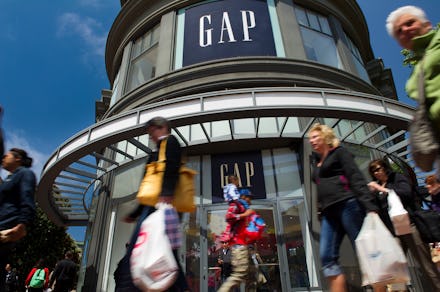Four Months After Raising Its Minimum Wage, Here's What Has Happened to Gap

The news: While Congress has been failing to make headway on minimum wage, several companies have started to raise employee salaries on their own, and they're already seeing real returns on their investments.
On Tuesday, Gap Inc. announced that since its recent pay floor increase, its seen a 10% boost in job applications since this time last year. While its brand Old Navy had been seeing declining interest from job seekers in the past few years, the new influx of applications means the company can afford to be more selective in its hiring choices.
"That we'd be able to be more competitive and attractive in getting the best talent we can find — that's where the benefit will come," Lynn Albright, vice president for Old Navy, told Bloomberg. "The more choices you have, the better selection you can make."
This is what Gap did: In February, Gap Inc. announced that it would raise minimum wage to $9 an hour this June and to $10 an hour by June 2015. The move is set to benefit 65,000 store employees throughout the country, but it's not a losing proposition for the company either.
By offering higher wages, Gap can attract high-quality applicants, encourage workers to be more efficient and prevent high turnovers, which can be expensive for the company. "Our decision to invest in frontline employees will directly support our business, and is one that we expect to deliver a return many times over," Gap Chairman and CEO Glenn Murphy said in a letter to employees.
Others companies are doing the same. Entry-level workers at In-N-Out Burger make $10.50 an hour, while those at Shake Shack receive $9.50 an hour (New York City residents get paid $10 an hour) with additional revenue sharing benefits. Starting salary at Costco is $11.50 an hour, with the average worker making nearly $22 an hour. And all these companies have reported greater employee satisfaction and performance since their respective salary boosts.
But of course, it's easier for a big company like Gap or Costco to make this transition than for a struggling mom-and-pop shop. One of the biggest arguments against a nationwide minimum wage increase is the worry that it will burden businesses and kill jobs, especially for unskilled workers. Still, projections indicate that if the national pay floor is increased to $10.10 per hour, around 21.3 million employees would receive pay increases — if they keep their jobs, that is. About 11% of the American workforce would get a raise.
Image Credit: The Economic Policy Institute
Despite overwhelming public support for raising the minimum wage, the ongoing congressional quagmire suggests that we shouldn't expect any nationwide measures in the foreseeable future. It'll be more likely to see more unilateral moves by Obama such as the recent salary raise for federal workers, or individual actions by states, cities or private corporations, such as Gap.